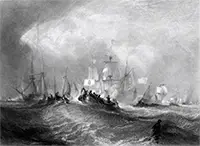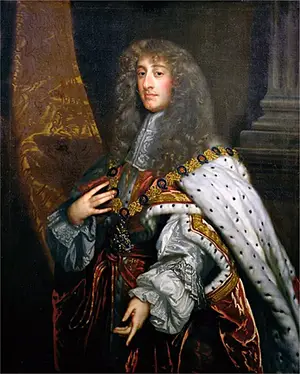James Stuart: the 'Old Pretender'
James Stuart, known as the "Old Pretender," lived a lifetime of longing to follow in his father's footsteps and rule as King of England. He never got the chance. 
He was born on June 10, 1688, at St. James Palace in London. At the time, his father was the ruling monarch, King James II. Young James's mother was Mary of Modena, who was the king's second wife. Both James and Mary were members of the Catholic faith, and young James was baptized into that faith as well. Tensions over religious beliefs had been high in England for nearly 200 years, after King Henry VIII broke with the Catholic Church and declared himself head of the Church of England. James II (left) was not at all willing to declare the A group of Protestant nobles had had enough of James and his favoritism toward Catholics, and they saw in the king's son a succession of Catholic monarchs. The solution, as these nobles saw it, was to find another monarch, one who wasn't Catholic. The solution that these monarchs arrived at was to embrace James's daughter Mary (an Anglican from birth) and, more importantly, her husband, the Protestant William of Orange, as the new monarchs. They ruled jointly as King William III and Queen Mary II. 
William accepted the invitation, gathered a large force of soldiers, and landed in Torbay, in Devon, England, on Nov. 5, 1688. The Dutch force was rather large: More than 400 ships brought more than 15,000 soldiers. Technically, James was able to lay claim to a force of about 25,000 soldiers. However, he had so alienated the English army by this point that most of those soldiers pledged their allegiance to the "invader," William and effectively refused to defend their king and country. James, at this point, fell ill himself and was in no position to fight. He also discovered that his other daughter, Princess Anne, had throw in her lot with her sister and so had her husband, the Prince of Denmark. On December 11, James fled the realm, taking his wife and young son with him. They went to France. The elder James, having failed in his one attempt to lead an armed invasion of England in 1690, died in 1701. The 13-year-old younger James had himself declared James III of England and James VIII of Scotland. His supporters became known as Jacobites, gathering in secret as needed, exchanging secret symbols out in public, and wearing a white rose on the birthday of the "Old Pretender" to show their secret support. King William III was still firmly in control of England and Scotland, however, and so not even the support of France's Louis XIV, James's cousin, amounted to much in the way of a restoration. James also had recognition of his claim from Spain and from the Vatican, but what he really needed was men and money. A change in monarch in 1702 resulted in the ascension of Queen Anne. A number of her subjects, particularly in Scotland and northern England, wanted to see James Stuart on the throne. Believing that he had a good shot at it, James in 1708 rounded up a number of French ships and soldiers and aimed to land in the Firth of Forth. It was nowhere near a triumph–quite the opposite, actually, as English forces under Admiral George Byng drove the invaders back across the Channel. 
James waited another seven years before he tried again. By this time, yet another ruler was on the throne: George I. James decided to try again in 1715. His supporters had started without him and had promptly lost two battles to English soldiers, at Sheriffmuir and Preston. James chose to land in Scotland in the middle of winter and promptly fell ill. He set up a pretender court at Scone Palace in January 1716. Hearing that English troops were on the way, he fled again to France just one month later. King Louis XIV died in that same year, and James lost his protection. He moved to Avignon, then owned by the Pope, and lived there for a time. Two years later, he went to Rome, where Pope Clement had offered him a palace. James's son Henry later became a Cardinal in the Church. James married Maria Sobieski, the granddaughter of the Polish king, in 1719. In that same year, Spain, involved in a war against Britain, landed troops in Scotland with the intent of pursuing yet another attempt at winning the throne for James. This one went the way of the previous ones, and Spanish troops returned home. James never made the trip. He had been briefly excited the year before, when Sweden's King Charles XII of Sweden had offered 10,000 troops to put at James's disposal; however, the death of the Swedish king during the final negotiations for that troop disbursement brought a new monarch to the Swedish throne and the ending of yet another Jacobite dream. Meanwhile, James had set up a court in exile, even going go far as to grant Jacobite Peerages to people from English and Scotland who visited him. James and Maria had two children, Charles (born in 1720) and Henry (1725). When Charles was born, father and son became known as the "Old Pretender" and the "Young Pretender". James never again tried to put himself on the English throne. He was more than happy to support his son in the 1745 Jacobite Rebellion and certainly shared in his son's disappointment when that invasion was repulsed. James Stuart died in 1766. |
|
Social Studies for Kids
copyright 2002–2024
David White



 Church of England the effective sole faith of the realm. He wanted Catholics to have more rights and more of a public ability to worship the way that they wanted to. Parliament did not agree with such measures, and James dissolved Parliament. He then appointed known Catholics to high-ranking posts within the government and the military. He went a step further in 1687 by issuing a Declaration of Indulgence, which granted complete religious toleration.
Church of England the effective sole faith of the realm. He wanted Catholics to have more rights and more of a public ability to worship the way that they wanted to. Parliament did not agree with such measures, and James dissolved Parliament. He then appointed known Catholics to high-ranking posts within the government and the military. He went a step further in 1687 by issuing a Declaration of Indulgence, which granted complete religious toleration.
